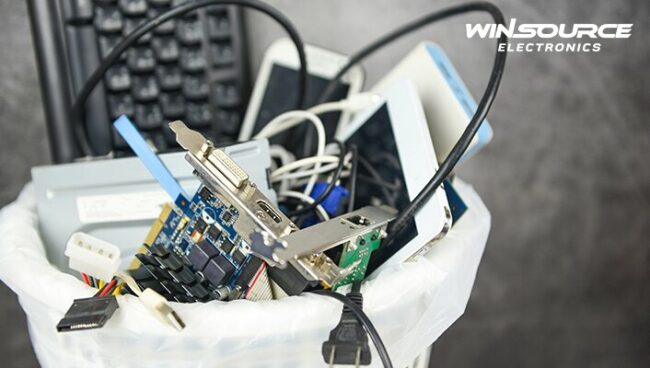
With the growing global awareness of environmental sustainability, there has been significant attention placed on the reuse and recycling of electronic components. As a result of their adverse environmental impact, electronic waste, or e-waste, has become a subject of increasing concern. In this article, we will explore the potential of reusing and recycling electronic components and evaluate whether it represents a viable solution to the challenges posed by e-waste.
The Potential of Reusing and Recycling Electronic Components: Recycling electronic components provides a promising pathway to reduce e-waste and safeguard precious resources. The emphasis of recycling lies not in processing whole electronic devices but in extracting usable components and materials from them. These components can subsequently undergo refurbishment, repairs, and reintegration into new products, thereby extending their lifespan and minimizing the need for new manufacturing.
Advantages of Reusing and Recycling Electronic Components:
Environmental Benefits: By reusing electronic components, we can significantly reduce the amount of e-waste ending up in landfills or incinerators, leading to environmental benefits. This practice not only decreases the demand for finite resources but also avoids the negative impacts of mining and manufacturing processes on the environment. Electronic devices contain valuable resources such as precious metals, rare earth elements, and plastics.
The extraction and processing of these resources have severe environmental consequences, including land degradation, water pollution, and air pollution. By recycling electronic components, we can effectively recover and reuse these resources, reducing the burden on the natural environment.
Energy and Cost Savings: Reusing components requires less energy compared to manufacturing new ones from scratch. It also reduces the demand for raw materials, thereby lowering production costs. This can have positive economic implications while simultaneously reducing carbon footprints associated with the manufacturing process.
Accessibility of Affordable Technology: Reusing recycled components can provide affordable access to technology, particularly in economically disadvantaged communities. It allows refurbished electronic devices to be offered at lower prices, enabling more people to benefit from modern technology without straining their budgets.
Challenges and Considerations
Compatibility and Performance: One key challenge in reusing electronic components is ensuring compatibility and performance. The recycled components may come from different batches of different devices, and they may have variations in specifications, form factors, and technical standards. Therefore, thorough testing, quality control, and compatibility checks are crucial to ensure reliable performance and avoid potential compatibility issues.
When recycled components are reused, they need to undergo rigorous testing and evaluation to ensure their functionality and performance meet the expected requirements. These tests cover multiple aspects, including electrical characteristics, mechanical durability, and functionality. By careful assessment and screening, potentially problematic or damaged components can be filtered out, ensuring only high-quality components are reused.
Technological obsolescence: Rapid advancements in technology often render older components obsolete. As technology evolves, the requirements and standards of electronic devices change, making it challenging to reuse certain recycled components. The fast pace of innovation can result in components that are no longer compatible with current systems or fail to meet the performance requirements of modern applications. Striking a balance between reusing components and adopting updated technologies to maintain compatibility and performance is crucial.
It requires a careful evaluation of the capabilities and limitations of recycled components in relation to the desired functionality and performance goals. In certain cases, adopting new technologies that offer improved efficiency, functionality, and compatibility may be more practical and cost-effective.
Safety and Reliability: Repurposed components should undergo rigorous testing and inspection to ensure their safety and reliability. Proper handling, refurbishment, and adherence to industry standards are essential to ensure that reused components meet quality and safety requirements. When recycling electronic components, standardized procedures and protocols for handling and refurbishing the components are crucial.
This includes thorough cleaning, repairing, or replacing damaged parts, as well as conducting tests to ensure that the components function properly and meet necessary safety standards.Furthermore, compliance with industry regulations and standards is vital to ensure the safe reuse of components. This involves adhering to guidelines related to electrical safety, electromagnetic compatibility, and environmental considerations, among others. Compliance with these standards helps mitigate potential risks associated with reusing components and ensures their reliable operation in new applications.
While reusing and recycling electronic components holds great potential in addressing e-waste and promoting sustainability, careful considerations must be given to compatibility, performance, and safety. Embracing a circular economy approach that focuses on reusing and refurbishing components can significantly reduce e-waste and conserve resources.
However, recognizing the limitations of reusing certain components is equally important in the face of technological advancements. By striking a balance between reuse and innovation, we can move closer to a more sustainable and environmentally responsible future.Decisions regarding the reuse of recycled electronic components should be guided by comprehensive assessments, testing, and adherence to safety standards. Through collective efforts and responsible practices, we can make significant strides in reducing e-waste and building a greener future.

COMMENTS